Selected Publications
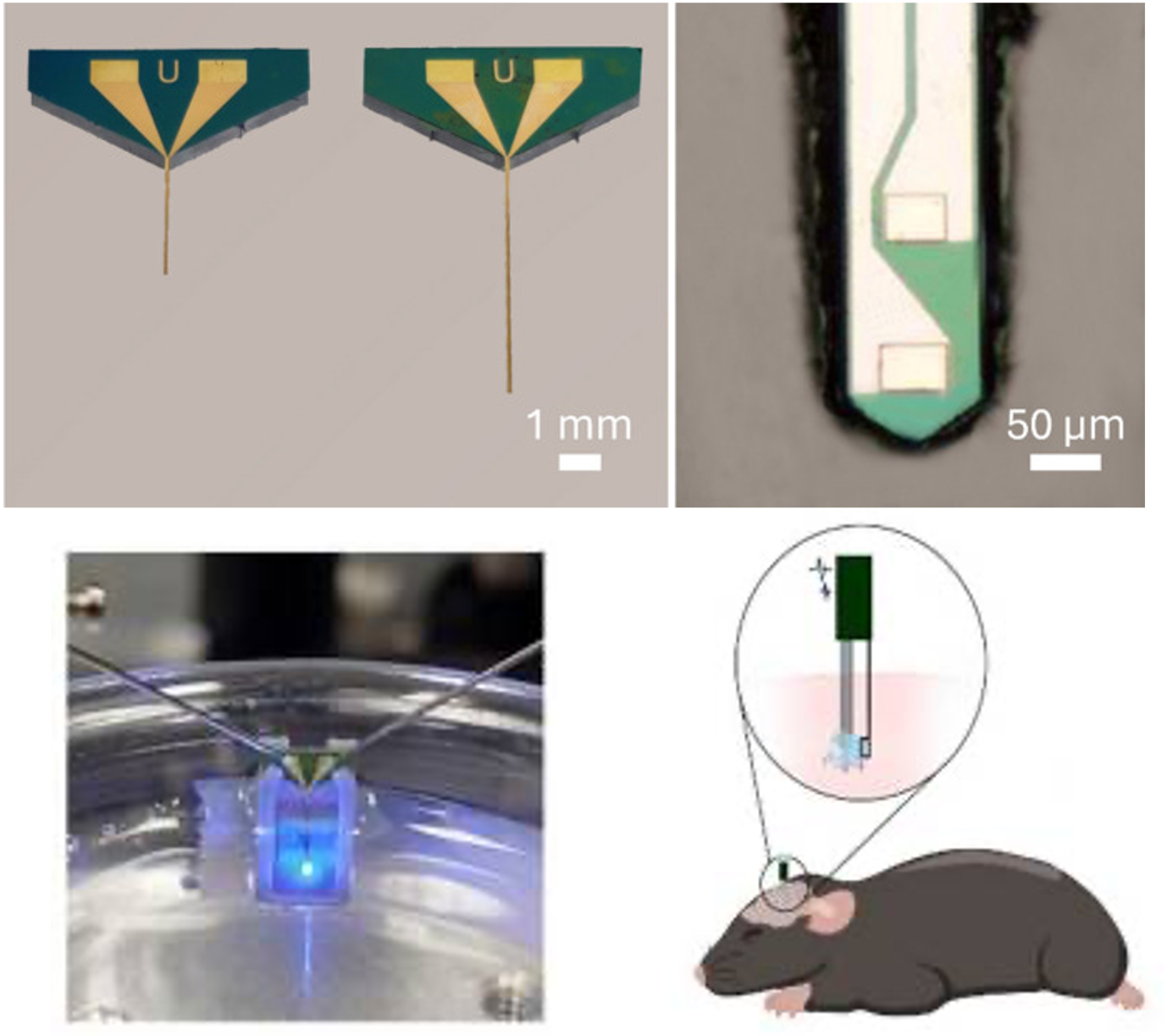
Biomedical Microdevices 2025
Abrantes M*, Pereira T*, Silva P, Falcão M, Borme J, Alpuim P, Jacinto L, *shared first authorship.
Optogenetics is a widely used tool to dissect neural circuits with optical stimulation, but it requires that light is delivered to photosensitive neurons inside the brain. Implantable neural probes with microscale LEDs (µLEDs) are an emerging approach to delivering light to the brain with superior light output control. We developed an implantable small form factor neural probe that integrates highly efficient commercial flip chip µLEDs using only standard lithography processes in silicon and a custom automated LED mounting approach with custom 3D-printed tools on a pick-and-place machine.
[pubmed] [pdf] [Biomed Microdevices]
Cellular and Molecular Bioengineering 2025
Silva P, Jacinto L
Recent advances in optoelectronic systems, materials science, and microtechnology have enabled the design and realization of miniaturized wirelessly-controlled optical stimulators for true untethered experiments in rodent models. In this work we critically review recent systems engineering and device design approaches to deliver light to the brain with wireless operation for optogenetic experiments. We describe strategies used for wireless control and communication, wireless power transfer, and light delivery to the brain with a focus on device integration for in vivo operation in freely behaving mice.
[pubmed] [pdf] [Cell Mol Bioeng]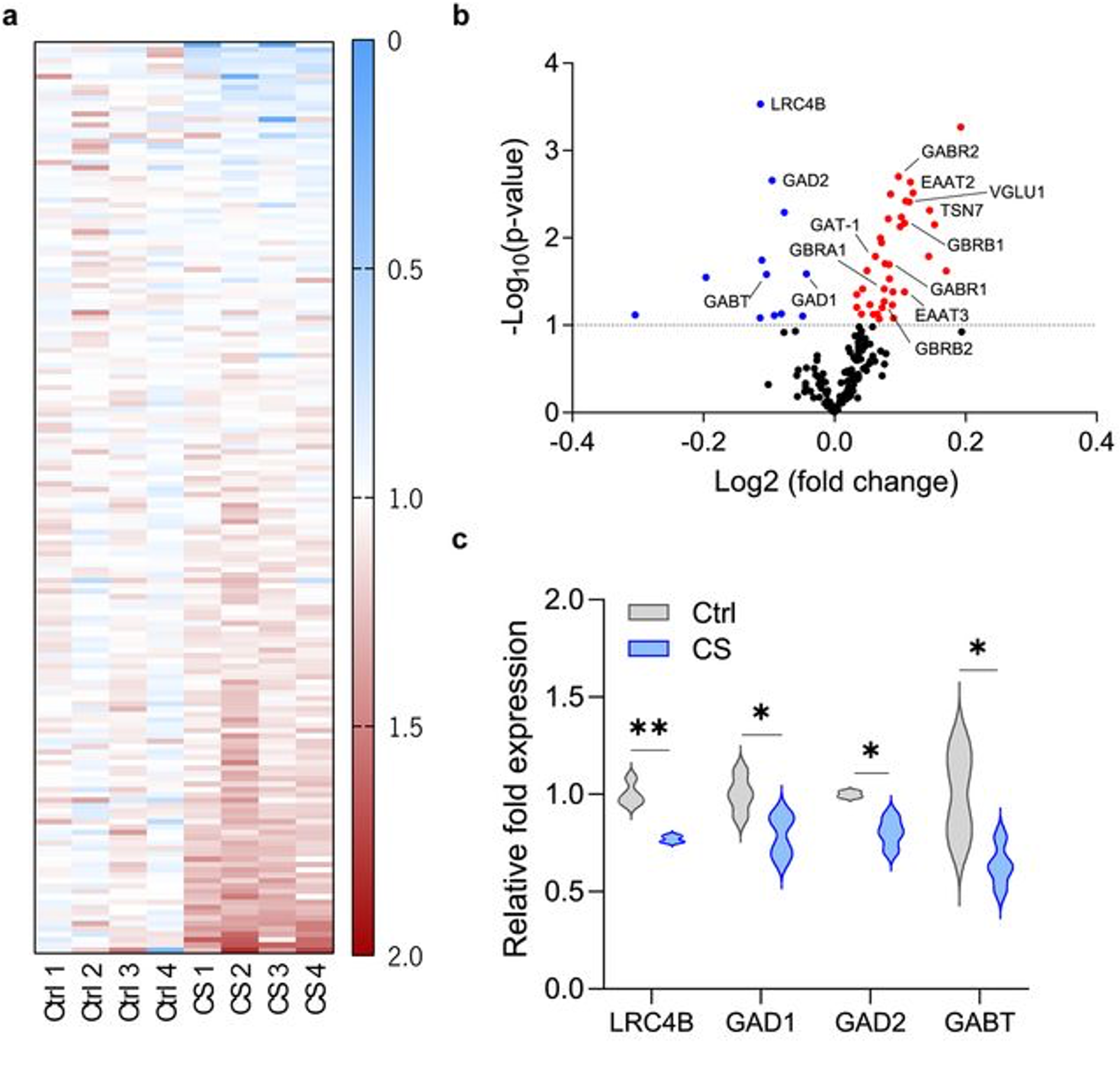
eNeuro 2024
Rodrigues D, Santa C, Manadas B, Monteiro P
This study reveals distinct impacts of chronic stress (CS) on synaptic inhibition-excitation balance (I/E ratio) within the medial prefrontal cortex’s infralimbic and prelimbic subregions. The differential modulation of I/E ratio in pyramidal neurons, coupled with the resilience of parvalbumin interneurons to CS within these subregions, underscores a nuanced susceptibility of prefrontal circuits. These findings contribute vital mechanistic insights into stress-related neuropsychiatric disorders. Moreover, this study includes a comprehensive proteomic dataset, providing a valuable resource for future studies to explore the molecular underpinnings of stress and its effects on neural circuits.
[pubmed] [pdf] [eNeuro]
Journal of Neurochemistry 2024
Falcão M, Monteiro P, Jacinto L
This review critically addresses recent findings regarding tactile processing deficits found in mouse models of ASD, with a focus on behavioral, anatomical, and functional alterations. Particular attention was given to cellular and circuit-level functional alterations, both in the peripheral and central nervous systems, with the objective of highlighting possible convergence mechanisms across models. By elucidating the impact of mutations in ASD candidate genes on somatosensory circuits and correlating them with behavioral phenotypes, this review significantly advances our understanding of tactile deficits in ASD. Such insights not only broaden our comprehension but also pave the way for future therapeutic interventions.
[pubmed] [pdf] [J Neurochem]
FEBS Letters 2024
Reis SL, Monteiro P
Autism spectrum disorder (ASD) is characterized by social impairments and repetitive behaviors, often accompanied by pronounced emotional complexities, including elevated anxiety rates. This review explores ASDs intricate relationship with atypical emotional processing, utilizing diverse animal models. Beyond altered sensory processing, we examine the contributions of altered threat processing and altered interoception. These multifaceted alterations may contribute to atypical phobias, prevalent anxiety disorders within this population.
[pubmed] [pdf] [FEBS Lett]
Translational Psychiatry 2023
Santa C*, Rodrigues D*, Coelho JF, Anjo SI, Mendes VM, Bessa-Neto D, Dunn MJ, Cotter D, Baltazar G, Monteiro P*, Manadas B* *shared first and senior authorship.
Striatal dysfunction has been implicated in the pathophysiology of schizophrenia, a disorder characterized by positive symptoms such as hallucinations and delusions. Haloperidol is a typical antipsychotic medication used in the treatment of schizophrenia that is known to antagonize dopamine D2 receptors, which are abundantly expressed in the striatum. However, haloperidol’s delayed therapeutic effect also suggests a mechanism of action that may go beyond the acute blocking of D2 receptors. By performing proteomics and whole-cell recordings in striatum, we suggest the slow remodeling of D1-neurons as a possible mechanism mediating the delayed therapeutic effect of haloperidol over striatum circuits. Understanding how haloperidol exactly contributes to treating schizophrenia symptoms may help to improve therapeutic outcomes and elucidate the molecular underpinnings of this disorder.
[pubmed] [pdf] [Transl Psychiatry]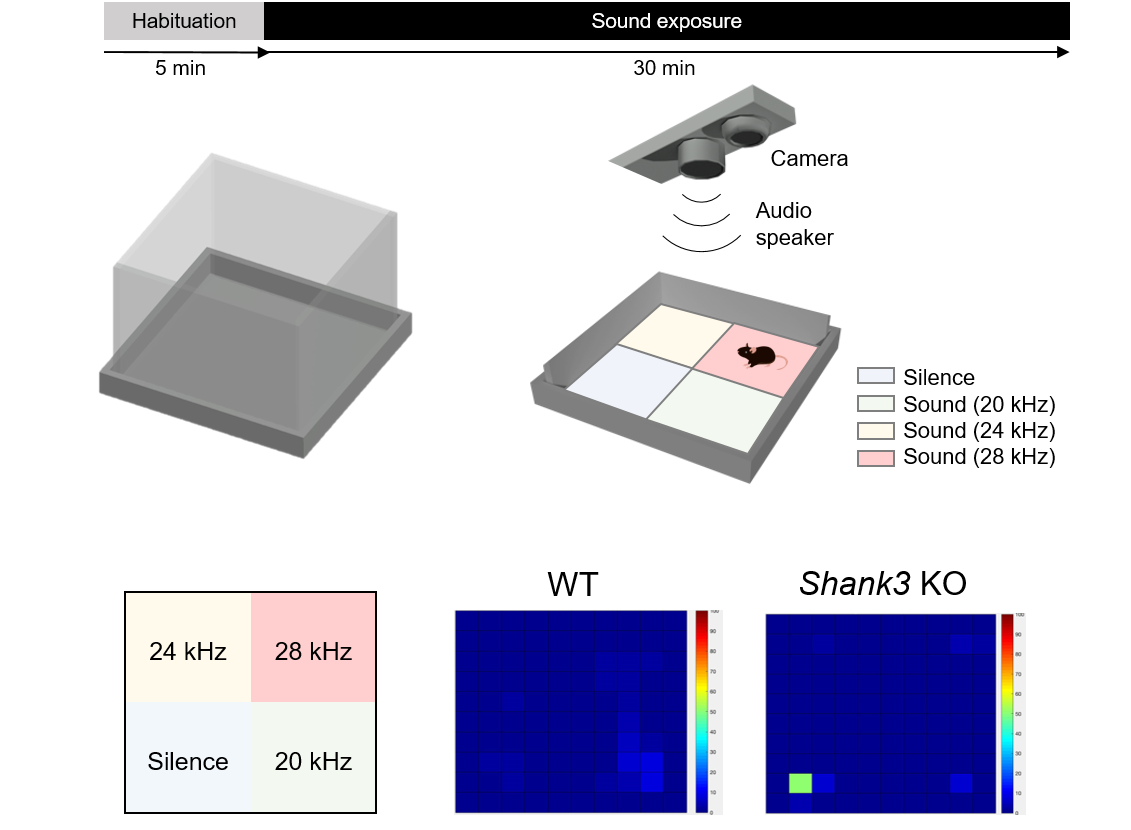
Frontiers in Behavioral Neuroscience 2023
Goncalves AM, Sousa N, Jacinto L, Monteiro P
Autism spectrum disorder (ASD) is characterized by deficits in communication and social interaction, restricted interests, repetitive behaviors, and sensory alterations, with auditory hypersensitivity being one of the most commonly reported sensory–perceptual abnormalities. Previous work has shown that mutant mice carrying a human ASD mutation in the Shank3 gene (InsG3680) exhibit repetitive behaviors and social interaction deficits, indicating important construct and face validity for this genotype as an animal model of ASD. To further address whether these mice also present auditory sensory–perceptual alterations, we developed a novel behavioral test in which mice can choose between different soundscapes. Our results reveal that, in comparison to wild-type mice, Shank3 mutants display a strong behavioral preference toward silent regions of the arena. These data suggest that Shank3- mutant mice might express an auditory hypersensitivity phenotype, further adding to their face validity as an animal model of ASD.
[pubmed] [pdf] [Front Behav Neurosci]
Neurobiology of Stress 2023
Rodrigues D, Monteiro P
Chronic stress (CS) is a well-recognized triggering factor in obsessive-compulsive disorder (OCD) and Tourette syndrome (TS), two neuropsychiatric disorders characterized by the presence of stereotypic motor symptoms. Planning and execution of motor actions are controlled by the dorsal striatum, a brain region that promotes or suppresses motor movement by activating striatal neurons from the direct- or indirect-pathway, respectively. Here, we report that CS in mice selectively potentiates the direct-pathway, while sparing the indirect-pathway. Specifically, we show that CS both increases excitation and reduces inhibition over direct-pathway neurons in the dorsomedial striatum (DMS). Furthermore, inhibitory interneurons located in the DMS also display reduced excitatory drive after chronic stress, thus amplifying striatal disinhibition.
[pubmed] [pdf] [Neurobiology of stress]
Nature Communications 2022
Rodrigues D, Jacinto L, Falcão M, Castro AC, Cruz A, Santa C, Manadas B, Marques F, Sousa N, Monteiro P
Chronic stress (CS) is associated with a number of neuropsychiatric disorders, and it may also contribute to or exacerbate motor function. However, the mechanisms by which stress triggers motor symptoms are not fully understood. Here, we report that CS functionally alters dorsomedial striatum (DMS) circuits in male mice, by affecting GABAergic interneuron populations and somatostatin positive (SOM) interneurons in particular. Specifically, we show that CS impairs communication between SOM interneurons and medium spiny neurons, promoting striatal overactivation/disinhibition and increased motor output. Using probabilistic machine learning to analyze animal behavior, we demonstrate that in vivo chemogenetic manipulation of SOM interneurons in DMS modulates motor phenotypes in stressed mice. Altogether, we propose a causal link between dysfunction of striatal SOM interneurons and motor symptoms in models of chronic stress.
[pubmed] [pdf] [Nat Commun]
Journal of Nanobiotechnology 2022
Abrantes M, Rodrigues D, Domingues T, Nemala SS, Monteiro P, Borme J, Alpuim P, Jacinto L
Detecting physiological levels of neurotransmitters in biological samples can advance our understanding of brain disorders and lead to improved diagnostics and therapeutics. However, neurotransmitter sensors for real-world applications must reliably detect low concentrations of target analytes from small volume working samples. Herein, a platform for robust and ultrasensitive detection of dopamine, an essential neurotransmitter that underlies several brain disorders, based on graphene multitransistor arrays (gMTAs) functionalized with a selective DNA aptamer is presented. The obtained limit-of-detection in dopamine-depleted brain homogenates spiked with dopamine was 1 aM (10^–18), overcoming sensitivity losses typically observed in ion-sensitive sensors in complex biological samples. Furthermore, we show that our gMTAs platform can detect minimal changes in dopamine concentrations in small working volume samples (2 µL) of cerebral spinal fluid samples obtained from a mouse model of Parkinson’s Disease. This platform can lead the way to graphene-based neurotransmitter sensors suitable for real-world academic and pre-clinical pharmaceutical research as well as clinical diagnosis.
[pubmed] [pdf] [J Nanobiotech]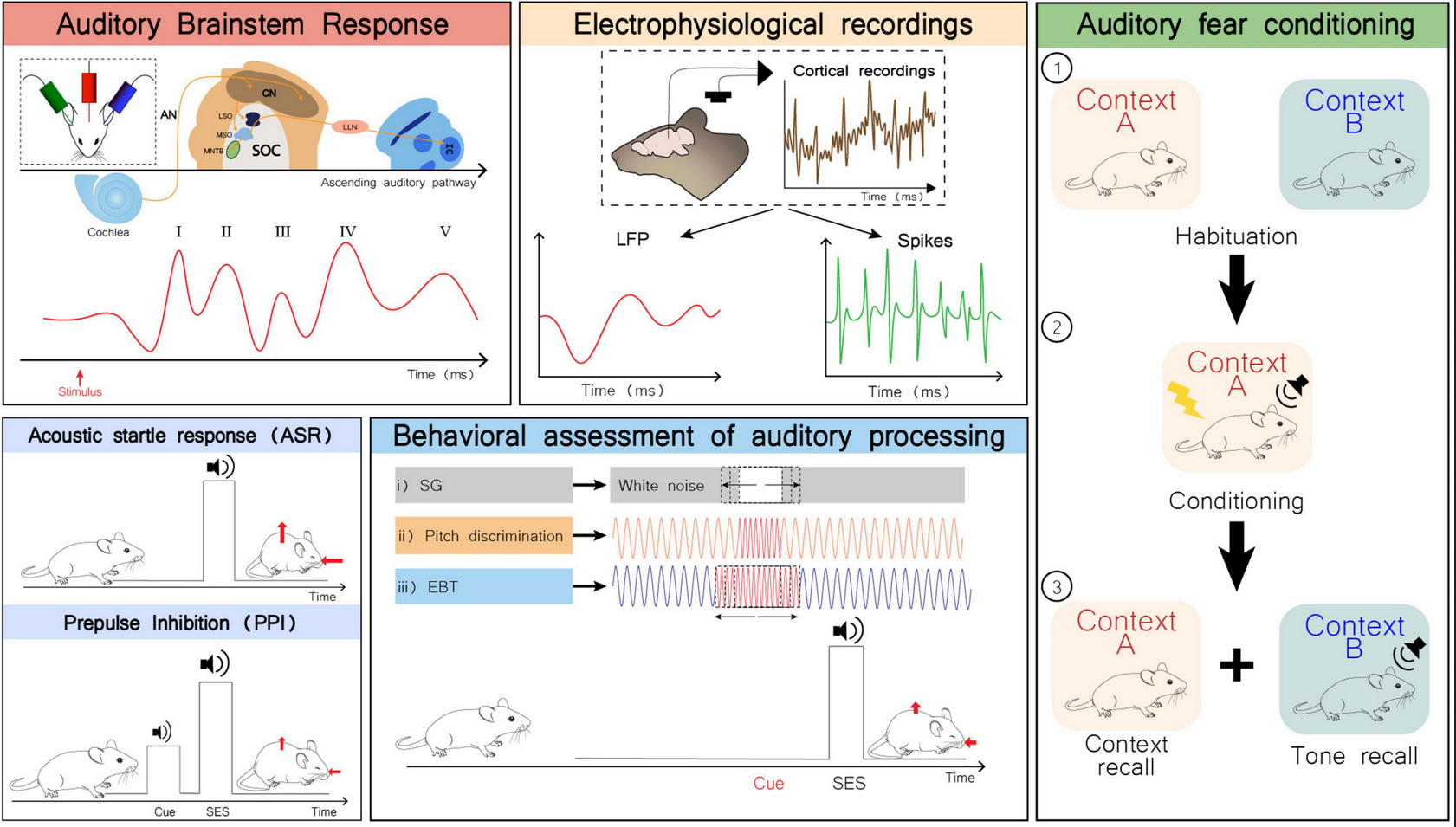
Frontiers in Molecular Neuroscience 2022
Castro AC, Monteiro P
Autism spectrum disorder (ASD) is a neurodevelopmental disorder mainly characterized by social-communication impairments, repetitive behaviors and altered sensory perception. Auditory hypersensitivity is the most common sensory-perceptual abnormality in ASD, however, its underlying neurobiological mechanisms remain elusive. Consistently with reports in ASD patients, animal models for ASD present sensory-perception alterations, including auditory processing impairments. Here we review the current knowledge regarding auditory dysfunction in rodent models of ASD, exploring both shared and distinct features among them, mechanistic and molecular underpinnings, and potential therapeutic approaches.
[pubmed] [pdf] [Front Mol Neurosci]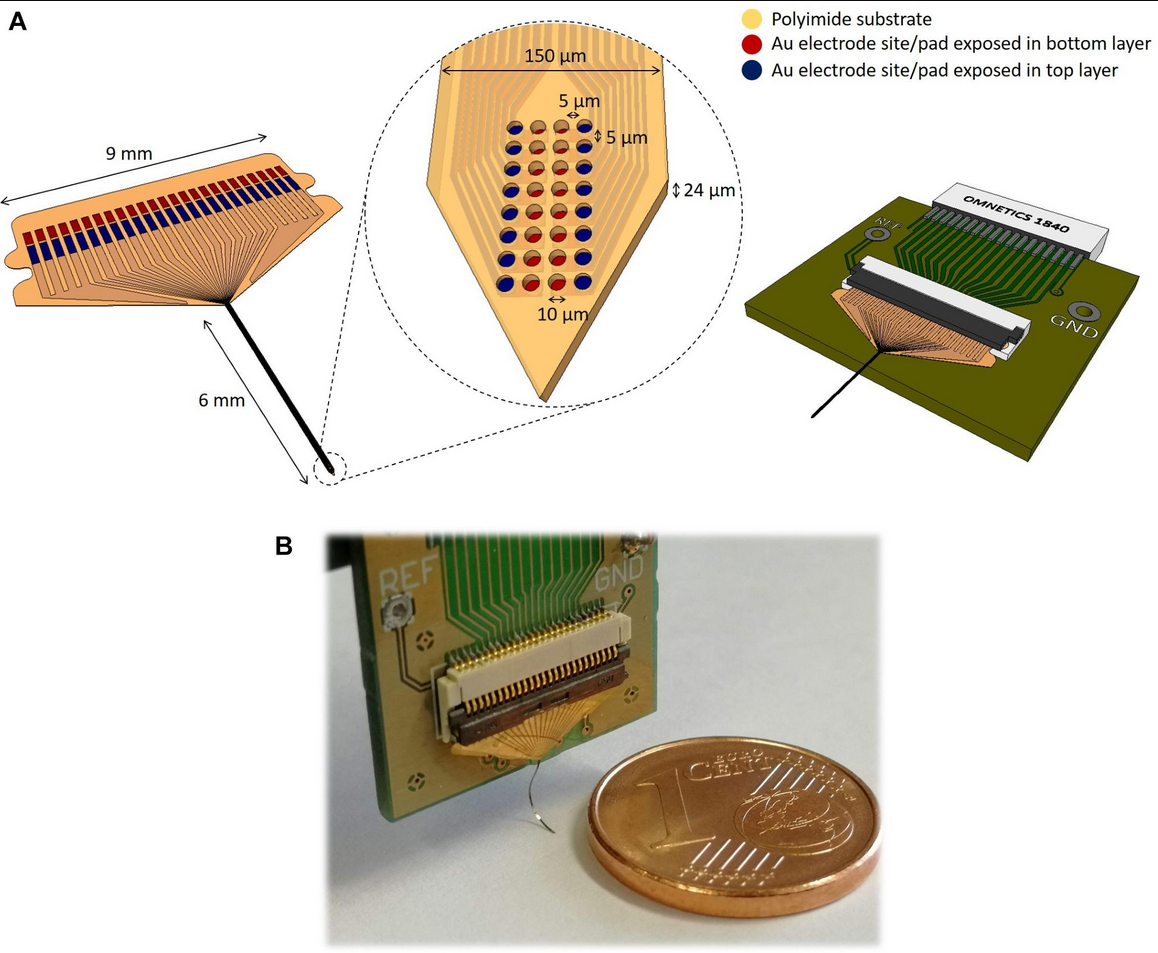
Frontiers in Neuroscience - Neural Technology 2021
Pimenta S, Rodrigues JA, Machado f; Ribeiro JF, Maciel MJ, Bondarchuk O, Monteiro P, Gaspar J, Correia JH, Jacinto L
Flexible polymer neural probes are an attractive emerging approach for invasive brain recordings, given that they can minimize the risks of brain damage or glial scaring. However, densely packed electrode sites, which can facilitate neuronal data analysis, are not widely available in flexible probes. Here, we present a new flexible polyimide neural probe, based on standard and low-cost lithography processes, which has 32 closely spaced 10 μm diameter gold electrode sites at two different depths from the probe surface arranged in a matrix, with inter-site distances of only 5 μm. The double-layer design and fabrication approach implemented also provides additional stiffening just sufficient to prevent probe buckling during brain insertion. In vivo functional tests and histological assessment of the insertion footprint, validate the biological applicability of this flexible neural probe for acquiring high quality neuronal recordings with high signal to noise ratio (SNR) and reduced acute trauma in rodents.
[pubmed] [pdf] [Front Neurosci]
Sensors 2021
Novais A, Calaza C, Fernandes F, Fonseca H, Monteiro P, Gaspar J, Jacinto L
Multisite neural probes are a fundamental tool to study brain function. Hybrid silicon/polymer neural probes combine rigid silicon and flexible polymer parts into one single device and allow, for example, the precise integration of complex probe geometries, such as multishank designs, with flexible biocompatible cabling. Despite these advantages and benefiting from highly reproducible fabrication methods on both silicon and polymer substrates, they have not been widely available. This paper presents the development, fabrication, characterization, and in vivo electrophysiological assessment of a hybrid multisite multishank silicon probe with a monolithically integrated polyimide flexible interconnect cable. The fabrication process was optimized at wafer level, and several neural probes with 64 gold electrode sites equally distributed along 8 shanks with an integrated 8 µm thick highly flexible polyimide interconnect cable were produced. The monolithic integration of the polyimide cable in the same fabrication process removed the necessity of the postfabrication bonding of the cable to the probe. This is the highest electrode site density and thinnest flexible cable ever reported for a hybrid silicon/polymer probe.
[pubmed] [pdf] [Sensors]
Journal of Neuroscience Methods 2020
Machado F, Sousa N, Monteiro P* and Jacinto L*
The demand for affordable tools for recording extracellular activity and successfully isolating single units from different brain preparations has pushed researchers and companies to invest in developing and fabricating new recording devices. However, depending on the brain region of interest, experimental question or type of preparation, different devices are required thus adding substantial financial burden to laboratories. We have developed a simple and affordable tetrode-based device that allows interchangeable extracellular recordings of neuronal activity between in vivo and ex vivo preparations and can be easily implemented in all wet-bench laboratories. This device allows custom tetrode configuration arrays and extensions for optogenetics and pharmacology, providing experimental flexibility not available in commercial off-the-shelf microelectrode arrays and silicon probes.
[pubmed] [pdf] [J Neurosci Methods]
Nature Reviews Neuroscience 2017
Monteiro P and Feng G
Several large-scale genomic studies have supported an association between cases of autism spectrum disorder and mutations in the genes SH3 and multiple ankyrin repeat domains protein 1 (SHANK1), SHANK2 and SHANK3, which encode a family of postsynaptic scaffolding proteins that are present at glutamatergic synapses in the CNS. An evaluation of human genetic data, as well as of in vitro and in vivo animal model data, may allow us to understand how disruption of SHANK scaffolding proteins affects the structure and function of neural circuits and alters behaviour.
[pubmed] [pdf] [Nat Rev Neurosci.]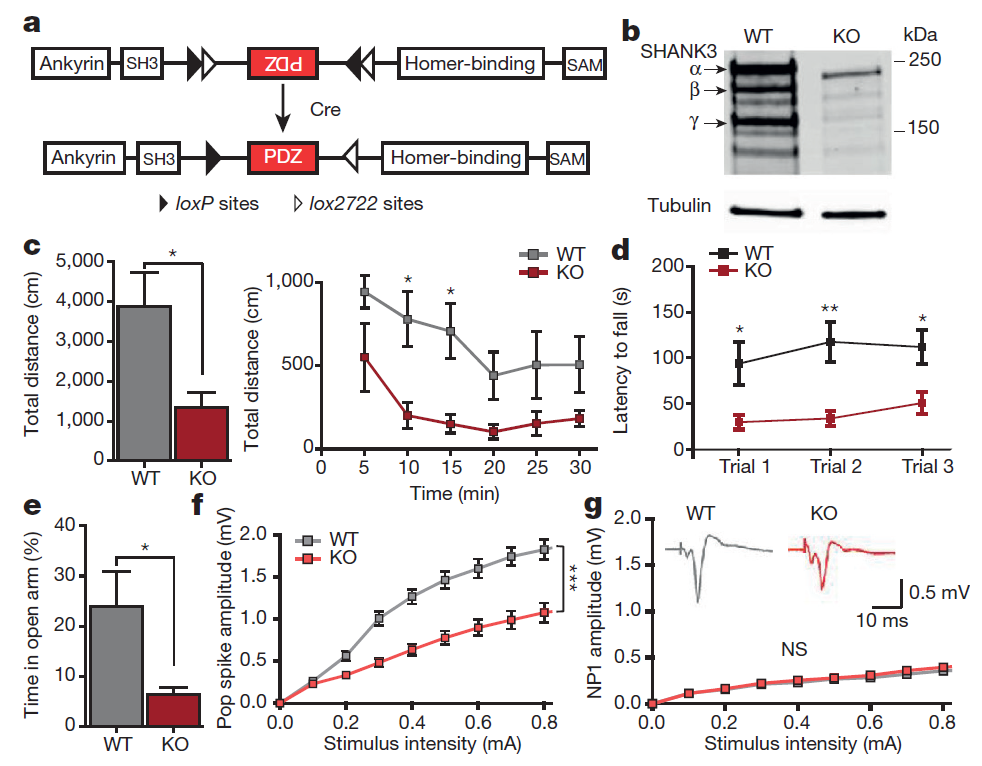
Nature 2016
Mei Y*, Monteiro P*, Zhou Y, Kim J, Gao X, Fu Z, Feng G
Because autism spectrum disorders are neurodevelopmental disorders and patients typically display symptoms before the age of three, one of the key questions in autism research is whether the pathology is reversible in adults. Here we investigate the developmental requirement of Shank3 in mice, a prominent monogenic autism gene that is estimated to contribute to approximately 1% of all autism spectrum disorder cases. SHANK3 is a postsynaptic scaffold protein that regulates synaptic development, function and plasticity by orchestrating the assembly of postsynaptic density macromolecular signalling complex. Disruptions of the Shank3 gene in mouse models have resulted in synaptic defects and autistic-like behaviours including anxiety, social interaction deficits, and repetitive behaviour. We generated a novel Shank3 conditional knock-in mouse model, and show that re-expression of the Shank3 gene in adult mice led to improvements in synaptic protein composition, spine density and neural function in the striatum. We also provide behavioural evidence that certain behavioural abnormalities including social interaction deficit and repetitive grooming behaviour could be rescued, while anxiety and motor coordination deficit could not be recovered in adulthood. Together, these results reveal the profound effect of post-developmental activation of Shank3 expression on neural function, and demonstrate a certain degree of continued plasticity in the adult diseased brain.
[pubmed] [pdf] [Nature]
Neuron 2016
Zhou Y, Kaiser T*, Monteiro P*, Zhang X*, Van der Goes MS, Wang D, Barak B, Zeng M, LiC, Lu C, Wells M, Amaya A, Nguyen S, Lewis M, Sanjana N, Zhou Y, Zhang M, Zhang F, Fu Z, Feng G
Genetic studies have revealed significant overlaps of risk genes among psychiatric disorders. However, it is not clear how different mutations of the same gene contribute to different disorders. We characterized two lines of mutant mice with Shank3 mutations linked to ASD and schizophrenia. We found both shared and distinct synaptic and behavioral phenotypes. Mice with the ASD-linked InsG3680 mutation manifest striatal synaptic transmission defects before weaning age and impaired juvenile social interaction, coinciding with the early onset of ASD symptoms. On the other hand, adult mice carrying the schizophrenia-linked R1117X mutation show profound synaptic defects in prefrontal cortex and social dominance behavior. Furthermore, we found differential Shank3 mRNA stability and SHANK1/2 upregulation in these two lines. These data demonstrate that different alleles of the same gene may have distinct phenotypes at molecular, synaptic, and circuit levels in mice, which may inform exploration of these relationships in human patients.
[pubmed] [pdf] [Neuron]
Science 2013
Burguiere E, Monteiro P, Feng G and Graybiel AM
Dysfunctions in frontostriatal brain circuits have been implicated in neuropsychiatric disorders, including those characterized by the presence of repetitive behaviors. We developed an optogenetic approach to block repetitive, compulsive behavior in a mouse model in which deletion of the synaptic scaffolding gene, Sapap3, results in excessive grooming. With a delay-conditioning task, we identified in the mutants a selective deficit in behavioral response inhibition and found this to be associated with defective down-regulation of striatal projection neuron activity. Focused optogenetic stimulation of the lateral orbitofrontal cortex and its terminals in the striatum restored the behavioral response inhibition, restored the defective down-regulation, and compensated for impaired fast-spiking neuron striatal microcircuits. These findings raise promising potential for the design of targeted therapy for disorders involving excessive repetitive behavior.
[pubmed] [pdf] [Science]